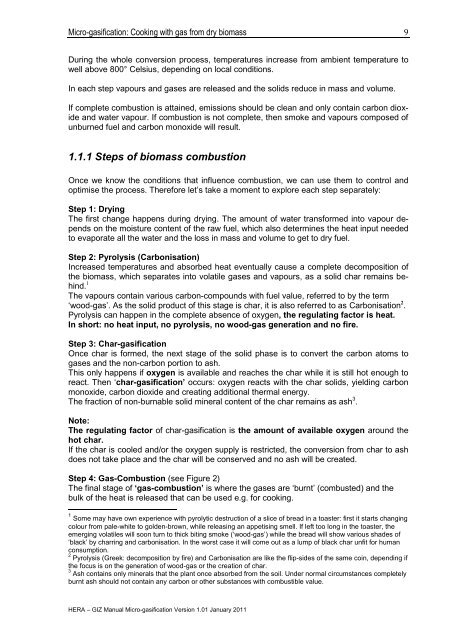Micro-gasification: Cooking with gas from biomass - Amper
Micro-gasification: Cooking with gas from biomass - Amper
Micro-gasification: Cooking with gas from biomass - Amper
You also want an ePaper? Increase the reach of your titles
YUMPU automatically turns print PDFs into web optimized ePapers that Google loves.
<strong>Micro</strong>-<strong><strong>gas</strong>ification</strong>: <strong>Cooking</strong> <strong>with</strong> <strong>gas</strong> <strong>from</strong> dry <strong>biomass</strong><br />
During the whole conversion process, temperatures increase <strong>from</strong> ambient temperature to<br />
well above 800° Celsius, depending on local conditions.<br />
In each step vapours and <strong>gas</strong>es are released and the solids reduce in mass and volume.<br />
If complete combustion is attained, emissions should be clean and only contain carbon dioxide<br />
and water vapour. If combustion is not complete, then smoke and vapours composed of<br />
unburned fuel and carbon monoxide will result.<br />
1.1.1 Steps of <strong>biomass</strong> combustion<br />
Once we know the conditions that influence combustion, we can use them to control and<br />
optimise the process. Therefore let‘s take a moment to explore each step separately:<br />
Step 1: Drying<br />
The first change happens during drying. The amount of water transformed into vapour depends<br />
on the moisture content of the raw fuel, which also determines the heat input needed<br />
to evaporate all the water and the loss in mass and volume to get to dry fuel.<br />
Step 2: Pyrolysis (Carbonisation)<br />
Increased temperatures and absorbed heat eventually cause a complete decomposition of<br />
the <strong>biomass</strong>, which separates into volatile <strong>gas</strong>es and vapours, as a solid char remains behind.<br />
1<br />
The vapours contain various carbon-compounds <strong>with</strong> fuel value, referred to by the term<br />
‗wood-<strong>gas</strong>‘. As the solid product of this stage is char, it is also referred to as Carbonisation 2 .<br />
Pyrolysis can happen in the complete absence of oxygen, the regulating factor is heat.<br />
In short: no heat input, no pyrolysis, no wood-<strong>gas</strong> generation and no fire.<br />
Step 3: Char-<strong><strong>gas</strong>ification</strong><br />
Once char is formed, the next stage of the solid phase is to convert the carbon atoms to<br />
<strong>gas</strong>es and the non-carbon portion to ash.<br />
This only happens if oxygen is available and reaches the char while it is still hot enough to<br />
react. Then ‗char-<strong><strong>gas</strong>ification</strong>‟ occurs: oxygen reacts <strong>with</strong> the char solids, yielding carbon<br />
monoxide, carbon dioxide and creating additional thermal energy.<br />
The fraction of non-burnable solid mineral content of the char remains as ash 3 .<br />
Note:<br />
The regulating factor of char-<strong><strong>gas</strong>ification</strong> is the amount of available oxygen around the<br />
hot char.<br />
If the char is cooled and/or the oxygen supply is restricted, the conversion <strong>from</strong> char to ash<br />
does not take place and the char will be conserved and no ash will be created.<br />
Step 4: Gas-Combustion (see Figure 2)<br />
The final stage of „<strong>gas</strong>-combustion‟ is where the <strong>gas</strong>es are ‗burnt‘ (combusted) and the<br />
bulk of the heat is released that can be used e.g. for cooking.<br />
1 Some may have own experience <strong>with</strong> pyrolytic destruction of a slice of bread in a toaster: first it starts changing<br />
colour <strong>from</strong> pale-white to golden-brown, while releasing an appetising smell. If left too long in the toaster, the<br />
emerging volatiles will soon turn to thick biting smoke (‗wood-<strong>gas</strong>‘) while the bread will show various shades of<br />
‗black‘ by charring and carbonisation. In the worst case it will come out as a lump of black char unfit for human<br />
consumption.<br />
2 Pyrolysis (Greek: decomposition by fire) and Carbonisation are like the flip-sides of the same coin, depending if<br />
the focus is on the generation of wood-<strong>gas</strong> or the creation of char.<br />
3 Ash contains only minerals that the plant once absorbed <strong>from</strong> the soil. Under normal circumstances completely<br />
burnt ash should not contain any carbon or other substances <strong>with</strong> combustible value.<br />
HERA – GIZ Manual <strong>Micro</strong>-<strong><strong>gas</strong>ification</strong> Version 1.01 January 2011<br />
9
















